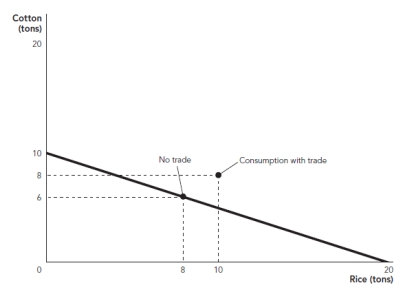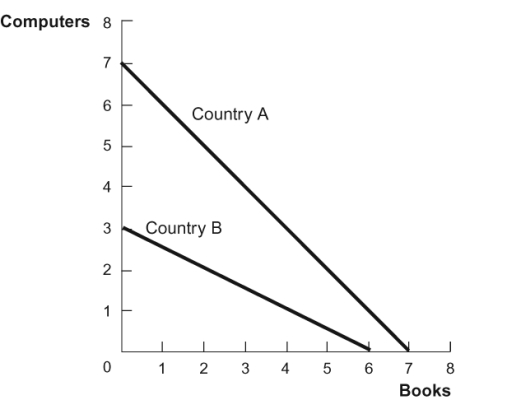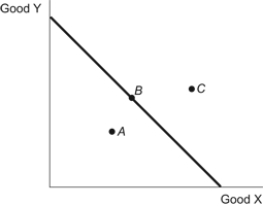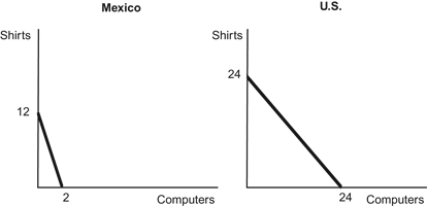A) a new process.
B) an old process that has consistently grown.
C) an old process that has grown intermittently.
D) an old process that has declined over time.
Correct Answer

verified
Correct Answer
verified
True/False
Trading increases the amount a single country can produce.
Correct Answer

verified
Correct Answer
verified
Multiple Choice
The better a person is at producing one good:
A) the worse he is at producing other goods.
B) the higher the opportunity cost to him of producing other goods.
C) the lower the incentive he has to trade with other people.
D) the better he is at producing other goods.
Correct Answer

verified
Correct Answer
verified
Multiple Choice
Traders should specialize in the good: that:
A) that they can produce with the lowest opportunity cost.
B) in which they have an absolute advantage.
C) in which their trading partner has a comparative advantage.
D) in which they do not have an absolute advantage.
Correct Answer

verified
Correct Answer
verified
Multiple Choice
Use the following to answer questions:
Figure: Rice and Shirts  -(Figure: Rice and Shirts) Use the PPFs shown for the United States and India. If the United States and India specialize and trade, one country will trade away 20 pounds of rice in exchange for 20 shirts from the other. Compared with no trade, ______ will be able to consume ______ additional shirts, and _____ will be able to consume an additional ______ pounds of rice.
-(Figure: Rice and Shirts) Use the PPFs shown for the United States and India. If the United States and India specialize and trade, one country will trade away 20 pounds of rice in exchange for 20 shirts from the other. Compared with no trade, ______ will be able to consume ______ additional shirts, and _____ will be able to consume an additional ______ pounds of rice.
A) the United States; 0; India; 8.6
B) India; 5; the United States; 0
C) the United States; 4; India; 8.6
D) India; 8.6; the United States; 4
Correct Answer

verified
Correct Answer
verified
Multiple Choice
Only a very small portion of people who use microwaves know how they work. This is an example of:
A) a production possibility frontier.
B) division of knowledge.
C) absolute advantage.
D) opportunity cost.
Correct Answer

verified
Correct Answer
verified
True/False
Poor countries are at a distinct disadvantage when it comes to economic production; they get outcompeted in everything since they do not have a comparative advantage in anything.
Correct Answer

verified
Correct Answer
verified
Multiple Choice
Which of the following situations would lead to more starvation?
A) a world where everyone grows his or her own food and there is no trade
B) a world with trade and lots of specialization
C) a world with immense division of knowledge
D) a world where only some people specialize in food and everyone else produces something else
Correct Answer

verified
Correct Answer
verified
Multiple Choice
A production possibilities frontier shows:
A) the supply and demand for a good in a country.
B) all combinations of goods that a country can produce given its productivity and supply of inputs.
C) the uninhabited territory of a country that is full of new possibilities.
D) the goods that a country will be able to produce in the future if it continues to grow.
Correct Answer

verified
Correct Answer
verified
True/False
In a world with trade, no one can afford to specialize.
Correct Answer

verified
Correct Answer
verified
Multiple Choice
Which of the following is typically a result of the division of knowledge?
A) The society runs with the knowledge of a few persons.
B) Each person has the same knowledge as everyone else.
C) Labor productivity is higher..
D) No one specializes in any activity.
Correct Answer

verified
Correct Answer
verified
True/False
Trade refers to the exchange of goods and services between at least two different nations.
Correct Answer

verified
Correct Answer
verified
True/False
As trade becomes more extensive, it slows down the creation of new ideas because fewer people can specialize in areas like science and engineering.
Correct Answer

verified
Correct Answer
verified
True/False
Specialization is an example of self-interest aligning with the social interest because it increases the amount you can consume as well as the amount society can consume.
Correct Answer

verified
Correct Answer
verified
Multiple Choice
Figure: Benin  In the figure, Benin has 32 workers, and the price per ton of cotton and ton of rice is $2,500 and $1,200, respectively. The average wage with no trade is ______, and the average wage with trade is ________.
In the figure, Benin has 32 workers, and the price per ton of cotton and ton of rice is $2,500 and $1,200, respectively. The average wage with no trade is ______, and the average wage with trade is ________.
A) $850; $1,081.25
B) $768.75; $1,000
C) $1,000; $850
D) $1,000; $1,081.25
Correct Answer

verified
Correct Answer
verified
Multiple Choice
Use the following to answer questions:
Figure: Computers and Books  -(Figure: Computers and Books) According to the figure, both countries can increase consumption if:
-(Figure: Computers and Books) According to the figure, both countries can increase consumption if:
A) both countries buy computers and books from each other.
B) both countries produce both computers and books.
C) country A produces only computers and buys books from country B.
D) country A produces only books and buys computers from country B.
Correct Answer

verified
Correct Answer
verified
Multiple Choice
Use the following to answer questions:
Figure: PPF Goods X & Y  -(Figure: PPF Goods X & Y) Refer to the figure. Point A represents an allocation of resources that is:
-(Figure: PPF Goods X & Y) Refer to the figure. Point A represents an allocation of resources that is:
A) efficient.
B) inefficient.
C) impossible.
D) the result of trade.
Correct Answer

verified
Correct Answer
verified
Multiple Choice
Use the following to answer questions:
Figure: PPF Mexico & United States  -(Figure: PPF Mexico & United States) Use the above figure in which both Mexico and the United States each have 24 units of labor. Mexico has a comparative advantage in ______ and the United States has a comparative advantage in ______.
-(Figure: PPF Mexico & United States) Use the above figure in which both Mexico and the United States each have 24 units of labor. Mexico has a comparative advantage in ______ and the United States has a comparative advantage in ______.
A) computers; shirts
B) shirts; computers
C) computers; computers
D) shirts; shirts
Correct Answer

verified
Correct Answer
verified
Multiple Choice
The recent pace of globalization has been increased through:
A) declining transportation costs.
B) increased speed of communication.
C) the integration of world markets.
D) each of these developments.
Correct Answer

verified
Correct Answer
verified
True/False
In a certain country it takes five of its 10 workers to produce one barrel of wine but only one worker to produce one yard of cloth. If we graphed this country's PPF (placing wine on the vertical axis and cloth on the horizontal axis), the slope of the PPF would equal -1/5.
Correct Answer

verified
Correct Answer
verified
Showing 181 - 200 of 239
Related Exams